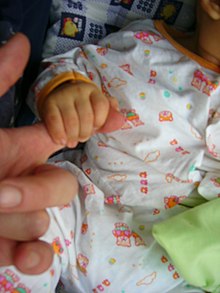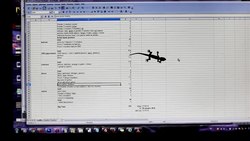Instinct is the inherent inclination of a living organism towards a particular complex behaviour, containing both innate(inborn) and learnt elements. The simplest example of an instinctive behavior is a fixed action pattern (FAP), in which a very short to medium length sequence of actions, without variation, are carried out in response to a corresponding clearly defined stimulus.
Any behavior is instinctive if it is performed without being based upon prior experience (that is, in the absence of learning), and is therefore an expression of innate biological factors. Sea turtles, newly hatched on a beach, will instinctively move toward the ocean. A marsupial climbs into its mother's pouch upon being born. Honeybees communicate by dancing in the direction of a food source without formal instruction. Other examples include animal fighting, animal courtship behavior, internal escape functions, and the building of nests. Though an instinct is defined by its invariant innate characteristics, details of its performance can be changed by experience; for example, a dog can improve its fighting skills by practice.
Instincts are inborn complex patterns of behavior that exist in most members of the species, and should be distinguished from reflexes, which are simple responses of an organism to a specific stimulus, such as the contraction of the pupil in response to bright light or the spasmodic movement of the lower leg when the knee is tapped. The absence of volitional capacity must not be confused with an inability to modify fixed action patterns. For example, people may be able to modify a stimulated fixed action pattern by consciously recognizing the point of its activation and simply stop doing it, whereas animals without a sufficiently strong volitional capacity may not be able to disengage from their fixed action patterns, once activated.
Instinctual behaviour in humans has been studied, and is a controversial topic.
History
In animal biology
Jean Henri Fabre (1823-1915), an entomologist, considered instinct to be any behavior which did not require cognition or consciousness to perform. Fabre's inspiration was his intense study of insects, some of whose behaviors he wrongly considered fixed and not subject to environmental influence.
Instinct as a concept fell out of favor in the 1920s with the rise of behaviorism and such thinkers as B. F. Skinner, which held that most significant behavior is learned.
An interest in innate behaviors arose again in the 1950s with Konrad Lorenz and Nikolaas Tinbergen, who made the distinction between instinct and learned behaviors. Our modern understanding of instinctual behavior in animals owes much to their work. For instance, there exists a sensitive period for a bird in which it learns the identity of its mother. Konrad Lorenz famously had a goose imprint on his boots. Thereafter the goose would follow whoever wore the boots. This suggests that the identity of the goose's mother was learned, but the goose's behavior towards what it perceived as its mother was instinctive.
In psychology
The term "instinct" in psychology was first used in the 1870s by Wilhelm Wundt. By the close of the 19th century, most repeated behavior was considered instinctual. In a survey of the literature at that time, one researcher chronicled 4,000 human "instincts," having applied this label to any behavior that was repetitive. In the early twentieth century, there was recognized a "union of instinct and emotion". William McDougall held that many instincts have their respective associated specific emotions. As research became more rigorous and terms better defined, instinct as an explanation for human behavior became less common. In 1932, McDougall argued that the word 'instinct' is more suitable for describing animal behaviour, while he recommended the word 'propensity' for goal directed combinations of the many innate human abilities, which are loosely and variably linked, in a way that shows strong plasticity. In a conference in 1960, chaired by Frank Beach, a pioneer in comparative psychology, and attended by luminaries in the field, the term 'instinct' was restricted in its application. During the 1960s and 1970s, textbooks still contained some discussion of instincts in reference to human behavior. By the year 2000, a survey of the 12 best selling textbooks in Introductory Psychology revealed only one reference to instincts, and that was in regard to Sigmund Freud's referral to the "id" instincts. In this sense, the term 'instinct' appeared to have become outmoded for introductory textbooks on human psychology.
Sigmund Freud considered that mental images of bodily needs, expressed in the form of desires, are called instincts.
In the 1950s, the psychologist Abraham Maslow argued that humans no longer have instincts because we have the ability to override them in certain situations. He felt that what is called instinct is often imprecisely defined, and really amounts to strong drives. For Maslow, an instinct is something which cannot be overridden, and therefore while the term may have applied to humans in the past, it no longer does.
The book Instinct: an enduring problem in psychology (1961) selected a range of writings about the topic.
In a classic paper published in 1972, the psychologist Richard Herrnstein wrote: "A comparison of McDougall's theory of instinct and Skinner's reinforcement theory — representing nature and nurture — shows remarkable, and largely unrecognized, similarities between the contending sides in the nature-nurture dispute as applied to the analysis of behavior."
F.B. Mandal proposed a set of criteria by which a behavior might be considered instinctual: a) be automatic, b) be irresistible, c) occur at some point in development, d) be triggered by some event in the environment, e) occur in every member of the species, f) be unmodifiable, and g) govern behavior for which the organism needs no training (although the organism may profit from experience and to that degree the behavior is modifiable).
In Information behavior: An Evolutionary Instinct (2010, pp. 35–42), Amanda Spink notes that "currently in the behavioral sciences instinct is generally understood as the innate part of behavior that emerges without any training or education in humans." She claims that the viewpoint that information behavior has an instinctive basis is grounded in the latest thinking on human behavior. Furthermore, she notes that "behaviors such as cooperation, sexual behavior, child rearing and aesthetics are [also] seen as 'evolved psychological mechanisms' with an instinctive basis." Spink adds that Steven Pinker similarly asserts that language acquisition is instinctive in humans in his book The Language Instinct (1994). In 1908, William McDougall wrote about the "instinct of curiosity" and its associated "emotion of wonder", though Spink's book does not mention this.
M.S. Blumberg in 2017 examined the use of the word instinct, and found it varied significantly.
In humans
The existence of the simplest instincts in humans is a widely debated topic. Among possible examples of instinct-influenced behavior in humans are the following.
- Congenital fear of snakes and spiders was found in six-month-old babies.
- Infant cry is believed to be a manifestation of instinct. The infant cannot otherwise protect itself for survival during its long period of maturation. The maternal and paternal bond manifest particularly in response to the infant cry. Its mechanism has been partly elucidated by observations with functional MRI of the parent’s brain.
- The herd instinct is found in human children and chimpanzee cubs, but is apparently absent in the young orangutans.
- Hormones are linked to specific forms of human behavior, such as sexuality. However, the topic remains debatable as human behavior was shown to influence hormonal levels. High levels of testosterone are often associated in a person (male or female) with aggressiveness, while its decrease is associated with nurturing and protective behavior. Decrease in testosterone level after the birth of a child was found among fathers.
- Hygiene behavior in humans was suggested to be partly instinctive, based on emotions such as disgust.
Reflexes
Examples of behaviors that do not require conscious will include many reflexes. The stimulus in a reflex may not require brain activity but instead may travel to the spinal cord as a message that is then transmitted back through the body, tracing a path called the reflex arc. Reflexes are similar to fixed action patterns in that most reflexes meet the criteria of a FAP. However, a fixed action pattern can be processed in the brain as well; a male stickleback's instinctive aggression towards anything red during his mating season is such an example. Examples of instinctive behaviors in humans include many of the primitive reflexes, such as rooting and suckling, behaviors which are present in mammals. In rats, it has been observed that innate responses are related to specific chemicals, and these chemicals are detected by two organs located in the nose: the vomeronasal organ (VNO) and the main olfactory epithelium (MOE).
Maturational
Some instinctive behaviors depend on maturational processes to appear. For instance, we commonly refer to birds "learning" to fly. However, young birds have been experimentally reared in devices that prevent them from moving their wings until they reached the age at which their cohorts were flying. These birds flew immediately and normally when released, showing that their improvement resulted from neuromuscular maturation and not true learning.
In evolution
Imprinting provides one example of instinct. This complex response may involve visual, auditory, and olfactory cues in the environment surrounding an organism. In some cases, imprinting attaches an offspring to its parent, which is a reproductive benefit to offspring survival. If an offspring has attachment to a parent, it is more likely to stay nearby under parental protection. Attached offspring are also more likely to learn from a parental figure when interacting closely. (Reproductive benefits are a driving force behind natural selection.)
Environment is an important factor in how innate behavior has evolved. A hypothesis of Michael McCollough, a positive psychologist, explains that environment plays a key role in human behaviors such as forgiveness and revenge. This hypothesis theorizes that various social environments cause either forgiveness or revenge to prevail. McCollough relates his theory to game theory. In a tit-for-tat strategy, cooperation and retaliation are comparable to forgiveness and revenge. The choice between the two can be beneficial or detrimental, depending on what the partner-organism chooses. Though this psychological example of game theory does not have such directly measurable results, it provides an interesting theory of unique thought. From a more biological standpoint, the brain's limbic system operates as the main control-area for response to certain stimuli, including a variety of instinctual behavior. The limbic system processes external stimuli related to emotions, social activity, and motivation, which propagates a behavioral response. Some behaviors include maternal care, aggression, defense, and social hierarchy. These behaviors are influenced by sensory input — sight, sound, touch, and smell.
Within the circuitry of the limbic system, there are various places where evolution could have taken place, or could take place in the future. For example, many rodents have receptors in the vomeronasal organ that respond explicitly to predator stimuli that specifically relate to that individual species of rodent. The reception of a predatory stimulus usually creates a response of defense or fear. Mating in rats follows a similar mechanism. The vomeronasal organ and the main olfactory epithelium, together called the olfactory system, detect pheromones from the opposite sex. These signals then travel to the medial amygdala, which disperses the signal to a variety of brain parts. The pathways involved with innate circuitry are extremely specialized and specific. Various organs and sensory receptors play parts in this complex process.
Instinct is a phenomenon that can be investigated from a multitude of angles: genetics, limbic system, nervous pathways, and environment. Researchers can study levels of instincts, from molecular to groups of individuals. Extremely specialized systems have evolved, resulting in individuals which exhibit behaviors without learning them.




